Learning How To Play On Acoustic Guitar is an exciting journey, and at guitarplayers.net, we’re here to guide you every step of the way with comprehensive acoustic guitar lessons tailored for guitar players of all levels. Unlock your musical potential with our expertly crafted tutorials and resources. Let’s explore everything from basic chords to advanced techniques. Dive in to discover new acoustic guitar skills, master essential techniques, and unlock your potential as a guitar player.
1. Establishing Proper Posture for Acoustic Guitar Playing
Perfecting your posture is paramount when learning how to play on acoustic guitar. It significantly impacts your progress and overall playing experience.
1.1 The Importance of Seating
The type of seat you choose can make or break your guitar playing.
- Avoid Low Sofas: Slouching in a soft sofa restricts movement and makes playing cumbersome, especially with larger acoustic guitars. Reaching over the guitar strains your posture and hinders your technique.
- Steer Clear of Armchairs: Armchairs limit your arm movement, causing you to tuck your elbow into your body. This cramped position is detrimental to proper guitar playing, where freedom of movement is essential.
- Say No to High Stools: High stools can cause your thighs to slope downwards, making the guitar unstable. A secure instrument is crucial for effective practice.
- Ideal Seating Conditions: Aim for a seat that allows your knees to be at a 90-degree angle or slightly inclined towards you. Your arms should move freely without any obstructions.
1.2 Achieving Optimal Posture
Adopting the correct posture sets the foundation for effective learning and prevents physical strain. Maintaining a straight back and relaxed shoulders allows for better reach and comfort.
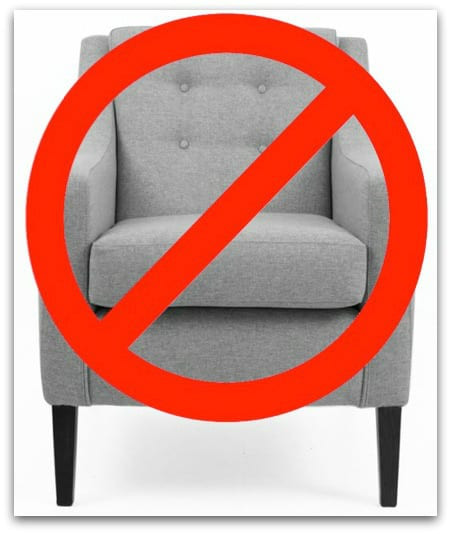 Proper posture for playing acoustic guitar, ensuring comfort and ease of reach
Proper posture for playing acoustic guitar, ensuring comfort and ease of reach
Alt text: Proper posture for playing acoustic guitar, ensuring comfort and ease of reach
According to research from the Berklee College of Music, proper posture enhances finger dexterity and reduces the risk of long-term injuries.
2. Essential Acoustic Guitar Anatomy for Beginners
Understanding the anatomy of your acoustic guitar is vital for mastering how to play on acoustic guitar. Key components include the fretboard, bridge, and machine heads.
2.1 The Fretboard
The fretboard is where you press your fingers to form chords and play individual notes. Unlike electric guitars, acoustics don’t require amplification, allowing you to focus on refining your hand techniques.
2.2 The Bridge
The bridge secures the strings in place, typically using pegs on an acoustic guitar.
2.3 The Machine Heads
Located on the headstock, machine heads are keys you turn to adjust the pitch of each string. These are crucial for tuning your guitar, which is fundamental to playing.
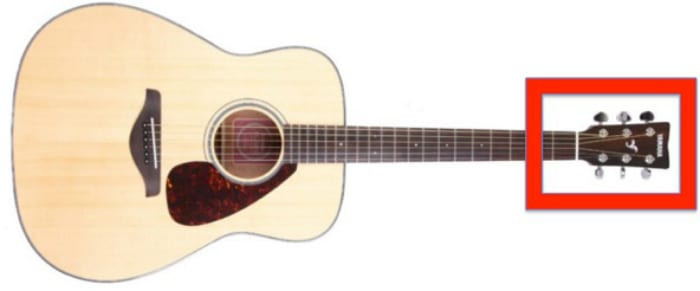 Machine heads, essential for tuning the guitar, adjusting pitch for accurate sound
Machine heads, essential for tuning the guitar, adjusting pitch for accurate sound
Alt text: Machine heads, essential for tuning the guitar, adjusting pitch for accurate sound
3. Tuning Your Acoustic Guitar: Notes of the Strings
Learning the names and numbers of the guitar strings is essential. In standard tuning, each string is tuned to a specific note.
- 6th String (Low E): The thickest string, tuned to E.
- 5th String (A): Tuned to A.
- 4th String (D): Tuned to D.
- 3rd String (G): Tuned to G.
- 2nd String (B): Tuned to B.
- 1st String (High E): The thinnest string, tuned to E.
3.1 Memorizing the String Notes
Use mnemonics to remember the string names effectively. Some popular examples include:
- Elephants And Dynamite Grow Big Ears
- Eddie Ate Dynamite Good Bye Eddie
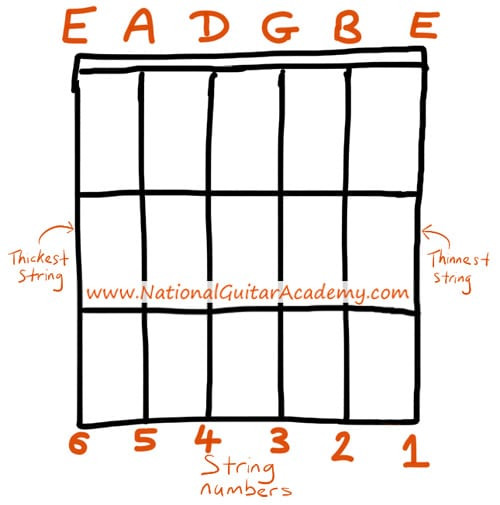 Guitar string numbers and names for easy learning
Guitar string numbers and names for easy learning
Alt text: Guitar string numbers and names for easy learning
4. Understanding Notes vs. Chords
Understanding the difference between notes and chords will give you a solid foundation as you learn how to play on acoustic guitar.
4.1 Defining a Note
A note is a single pitch produced by plucking one string.
4.2 Defining a Chord
A chord is a combination of multiple notes played simultaneously.
4.3 Analogy
Think of notes as letters and chords as words. A G chord, for example, combines several notes played together.
5. Focusing on Chords for Beginners
For beginners, focusing on chords is more practical than individual notes. Chords form the basis of songs and provide a quick path to musical expression.
5.1 What Are Chords?
A chord is a group of notes strummed together, such as strumming the G, B, and E strings simultaneously.
5.2 Why Start with Chords?
Chords are more accessible for beginners, allowing you to play songs sooner and build confidence.
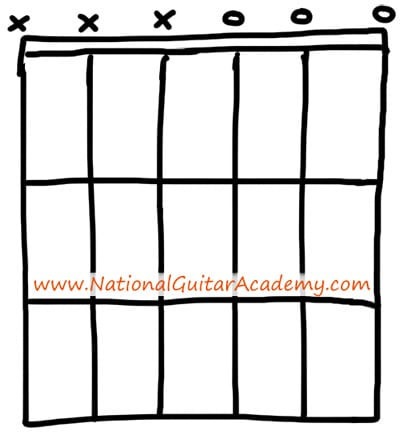 Em guitar chord diagram, illustrating finger placement on the fretboard
Em guitar chord diagram, illustrating finger placement on the fretboard
Alt text: Em guitar chord diagram, illustrating finger placement on the fretboard
6. Perfecting Your Chord Technique
Mastering how to fret chords correctly is vital for producing clear and clean sounds when you learn how to play on acoustic guitar.
6.1 Using Your Fingertips
Use the tips of your fingers, rather than the fleshy parts, to fret the strings. This maximizes space between strings, allowing each note to ring clearly.
6.2 Finger Placement
Place your fingers in the middle of the frets, not directly on them. This prevents deadened notes and ensures clean articulation.
6.3 Thumb Position
Keep your thumb in the middle of the neck, pointing towards the ceiling, for most chords.
6.4 Importance of Clear Notes
Ensure each note rings out clearly and cleanly. Practice slowly and deliberately to improve your accuracy.
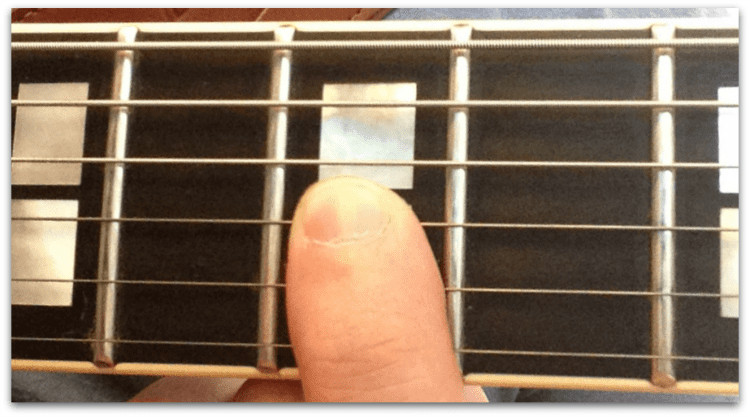 Proper finger placement on the fretboard for clear and accurate chord playing
Proper finger placement on the fretboard for clear and accurate chord playing
Alt text: Proper finger placement on the fretboard for clear and accurate chord playing
7. Learning Easy Beginner Guitar Chords
Starting with simple chords makes learning how to play on acoustic guitar more accessible and enjoyable. These chords are the building blocks for countless songs.
7.1 The E Minor (Em) Chord
The E minor chord is a great starting point due to its simple finger placement. Place your middle finger on the 2nd fret of the A string and your ring finger on the 2nd fret of the D string. Strum all six strings.
7.2 The C Major (C) Chord
To play the C major chord, place your index finger on the 1st fret of the B string, your middle finger on the 2nd fret of the D string, and your ring finger on the 3rd fret of the A string. Avoid strumming the 6th string.
7.3 The G Major (G) Chord
The G major chord requires a bit more finger dexterity. Place your middle finger on the 2nd fret of the A string, your index finger on the 2nd fret of the E string, and your ring finger on the 3rd fret of the B string. Strum all six strings.
7.4 The D Major (D) Chord
For the D major chord, place your index finger on the 2nd fret of the G string, your middle finger on the 2nd fret of the high E string, and your ring finger on the 3rd fret of the B string. Strum the strings from D (4th string) down.
8. Mastering Strumming Techniques
Strumming is a fundamental skill for anyone learning how to play on acoustic guitar. It brings rhythm and life to your chords, making your playing sound musical.
8.1 Holding the Guitar Pick
Hold the pick between your thumb and index finger, with just a small portion of the pick exposed. Experiment with different angles to find what feels most comfortable.
8.2 Basic Strumming Patterns
Start with simple downstrokes and upstrokes. Gradually incorporate more complex patterns as you become comfortable.
8.3 Keeping Time
Use a metronome or drum beat to keep time. Consistent rhythm is essential for sounding professional.
8.4 Practicing Smooth Transitions
Practice transitioning smoothly between chords while maintaining a steady strumming pattern. This is key to playing songs seamlessly.
9. Playing Easy Beginner Acoustic Guitar Songs
Once you know a few basic chords and strumming techniques, you can start playing simple songs. This is a rewarding way to reinforce your skills and build confidence.
9.1 “Knockin’ on Heaven’s Door” by Bob Dylan
This classic song uses just four chords: G, D, Am, and C. The simple chord progression makes it ideal for beginners.
9.2 “Leaving on a Jet Plane” by John Denver
Another great choice, this song features the chords G, C, D, and Em. The straightforward strumming pattern makes it easy to play along.
9.3 “Hallelujah” by Leonard Cohen
While it has a few more chords, “Hallelujah” is manageable for beginners. The chords include C, G, Am, F, and Em.
10. How Can You Personalize Your Guitar-Learning Plan?
Personalizing your guitar-learning plan is essential to mastering how to play on acoustic guitar efficiently.
- GuitarMetrics™: Consider using tools like GuitarMetrics™ to create a custom guitar-learning plan tailored to your specific goals and skill level.
- Set Clear Goals: Define what you want to achieve with your guitar playing, whether it’s learning specific songs, mastering certain techniques, or performing live.
- Regular Practice: Consistent practice is key to improvement. Set aside dedicated time each day or week to practice, even if it’s just for 15-30 minutes.
11. Why Should You Explore World-Class Guitar Courses?
Enrolling in world-class guitar courses can significantly accelerate your learning journey and take your skills to the next level.
- Expert Instruction: Learn from experienced instructors who can provide valuable feedback and guidance.
- Structured Curriculum: Benefit from a well-designed curriculum that covers all essential aspects of guitar playing.
- Community Support: Connect with fellow guitar enthusiasts, share your progress, and learn from others.
12. How To Enhance Your Guitar Playing With Music Theory
Understanding basic music theory concepts enhances your ability to learn how to play on acoustic guitar.
12.1 Scales
Scales are sequences of notes arranged in ascending or descending order. Learning scales helps you understand the relationships between notes and improve your improvisation skills.
12.2 Keys
A key is a set of notes that form the basis of a song. Understanding keys helps you identify chords and melodies that fit together harmoniously.
12.3 Chord Progressions
Chord progressions are sequences of chords that create a musical structure. Learning common chord progressions helps you write your own songs and understand the structure of existing ones.
13. Exploring Different Acoustic Guitar Styles
Different acoustic guitar styles cater to various musical tastes and preferences.
13.1 Fingerstyle
Fingerstyle involves playing the guitar by plucking individual strings with your fingers, rather than using a pick. This style allows for intricate arrangements and complex harmonies.
13.2 Flatpicking
Flatpicking is a style of playing the guitar with a pick, typically used in bluegrass and country music. It emphasizes fast, precise picking and often involves intricate lead lines.
13.3 Strumming
Strumming is the most common acoustic guitar style, involving rhythmically strumming chords to accompany vocals or create a full, rich sound.
14. Maintaining Your Acoustic Guitar
Proper maintenance is essential for keeping your acoustic guitar in good condition and ensuring it sounds its best.
14.1 Cleaning
Regularly clean your guitar with a soft cloth to remove dirt, dust, and fingerprints.
14.2 String Changes
Change your strings regularly, typically every 1-3 months, to maintain optimal sound quality.
14.3 Humidity Control
Keep your guitar in a stable humidity environment to prevent damage to the wood.
14.4 Professional Setups
Consider getting your guitar professionally set up by a qualified technician to ensure it plays optimally.
15. What Is The Role Of Guitar Accessories?
Guitar accessories can enhance your playing experience and help you get the most out of your acoustic guitar.
15.1 Picks
Experiment with different types of picks to find what feels most comfortable and produces the desired sound.
15.2 Capos
A capo is a device that clamps onto the fretboard, raising the pitch of all the strings. It allows you to play songs in different keys without changing the chord shapes.
15.3 Straps
Use a guitar strap to comfortably play your acoustic guitar while standing.
15.4 Tuners
A reliable tuner is essential for keeping your guitar in tune.
16. Connecting with the Acoustic Guitar Community
Connecting with other guitar players can provide valuable support, inspiration, and learning opportunities.
16.1 Online Forums
Join online guitar forums to ask questions, share your progress, and connect with fellow enthusiasts.
16.2 Local Music Stores
Visit local music stores to meet other guitar players, attend workshops, and participate in jam sessions.
16.3 Social Media Groups
Join guitar-related groups on social media platforms to connect with a wider community of players.
17. Exploring Acoustic Guitar Brands and Models
Choosing the right acoustic guitar can make a significant difference in your playing experience.
17.1 Popular Brands
Some popular acoustic guitar brands include Martin, Taylor, Gibson, and Fender.
17.2 Body Styles
Acoustic guitars come in various body styles, such as dreadnought, grand auditorium, and parlor. Each style produces a different sound and offers a unique playing experience.
17.3 Wood Types
The type of wood used in an acoustic guitar affects its tone. Common wood types include spruce, mahogany, and rosewood.
18. Attending Acoustic Guitar Events and Workshops
Attending guitar events and workshops can provide valuable learning opportunities and networking opportunities.
18.1 Guitar Festivals
Attend guitar festivals to see performances by renowned guitarists, participate in workshops, and connect with other enthusiasts.
18.2 Local Workshops
Attend local guitar workshops to learn new techniques, improve your skills, and get feedback from experienced instructors.
19. The Importance Of Recording Your Progress
Recording yourself playing guitar can be a valuable tool for self-assessment and improvement.
19.1 Identifying Areas for Improvement
Listen to your recordings to identify areas where you can improve your technique, timing, and overall sound.
19.2 Tracking Your Progress
Compare your recordings over time to track your progress and see how far you’ve come.
20. Setting Realistic Goals
Setting achievable goals keeps you motivated and focused while mastering how to play on acoustic guitar.
20.1 Start Small
Begin with small, manageable goals, such as learning a new chord each week or mastering a simple song.
20.2 Celebrate Your Achievements
Acknowledge and celebrate your progress along the way to stay motivated and encouraged.
20.3 Stay Persistent
Don’t get discouraged by setbacks. Persistence and dedication are key to achieving your guitar-playing goals.
FAQ: How To Play On Acoustic Guitar
1. What is the first thing I should learn on acoustic guitar?
The first thing you should learn is proper posture and how to hold the guitar correctly, followed by basic chords like E minor, C major, G major, and D major.
2. How long does it take to learn acoustic guitar?
The time it takes to learn acoustic guitar varies depending on your dedication and practice habits. With consistent practice, you can learn basic chords and play simple songs within a few months.
3. Is it harder to learn acoustic or electric guitar?
Acoustic guitars generally have thicker strings and require more finger strength than electric guitars. However, acoustics are simpler in terms of setup and don’t require additional equipment like amplifiers.
4. How often should I practice guitar?
Ideally, you should practice guitar every day, even if it’s just for 15-30 minutes. Consistent practice is more effective than infrequent, long sessions.
5. What are the best exercises for beginner guitar players?
Effective exercises include practicing chord transitions, strumming patterns, and scales. Finger exercises can also help improve dexterity and strength.
6. What is the best way to tune an acoustic guitar?
The best way to tune an acoustic guitar is by using an electronic tuner or a tuning app. Ensure each string is tuned to the correct note: E, A, D, G, B, and E.
7. How do I prevent finger pain when learning guitar?
To prevent finger pain, start with light-gauge strings, practice in short sessions, and use your fingertips to fret the strings. Building calluses on your fingertips will also help reduce pain over time.
8. Can I learn acoustic guitar online?
Yes, there are many online resources, including video lessons, tutorials, and courses, that can help you learn acoustic guitar. Websites like guitarplayers.net offer comprehensive lessons for all skill levels.
9. What is the best acoustic guitar for beginners?
A good beginner acoustic guitar should be affordable, comfortable to play, and have a decent sound. Popular options include Yamaha FG800, Fender FA-115, and Epiphone DR-100.
10. How do I change guitar strings?
To change guitar strings, loosen the old strings, remove them from the bridge and tuning pegs, and then install the new strings. Stretch the new strings and tune them to the correct pitch.
Ready to take your guitar playing to the next level? Explore guitarplayers.net for a wealth of lessons, reviews, sheet music, and a thriving community of guitar enthusiasts. Whether you’re seeking free lessons, detailed gear reviews, or a place to connect with fellow musicians, guitarplayers.net is your ultimate resource. Start your journey today and unlock your full potential as a guitar player. Visit us at 1140 Boylston Street, Boston, MA 02215, United States, or call +1 (617) 747-2261 to learn more.
